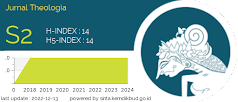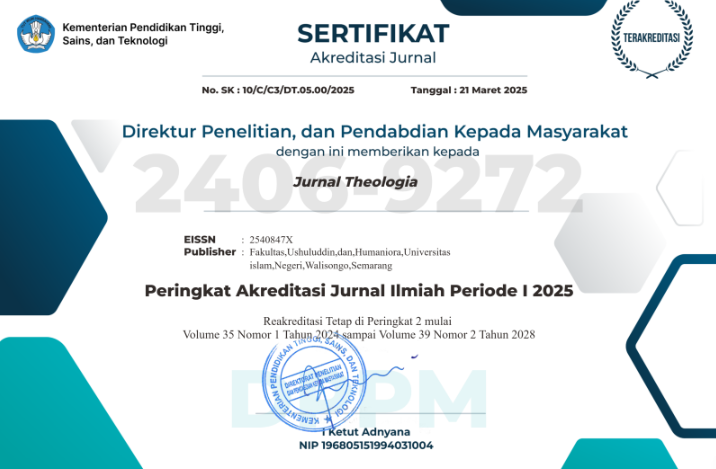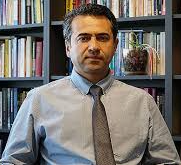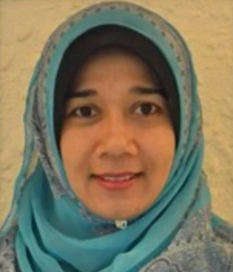MEDIATIZATION OF ISLAMIC DOCTRINE IN A NEW ERA OF DIGITAL INDONESIA: The Case of Ḥadīth on Dajjāl
DOI:
https://doi.org/10.21580/teo.2019.30.2.4327Keywords:
ḥadīth on the End of Time, mediatization Islamic doctrine, Dajjāl, fitnaAbstract
This research is a study of the mediatization of the ḥadīth on Dajjāl (the anti-Christ) in the context of media culture. Mediatization of the ḥadīth through illustrations allows every Muslim to understand the stages and events that will occur at the End of the Time (Ākhir al-Zamān). Such ḥadīth is pre-actual doctrinal texts in Islam. This article uses the theory of mediatization that has a close link with the discipline of media studies and religiosity. We argue that the ḥadīth illustration as an expression of religious beliefs is a continuation of the massive use of technology in understanding religious doctrines. On the other hand, the illustration of the ḥadīth. Ḥadīth on the Dajjāl in digital media has formed a new pattern in the understanding of ḥadīth from abstract-imaginative to concrete-imaginative. The illustration of the Dajjāl has become an indication of the widespread role of the media in the spread of Islamic doctrines, and its changing role from being dominated by the texts to being dominated by the logic of religion. This research uses the theory of mediatization with the approach of media culture. The data is obtained from footage of such ḥadīth documentary airing on YouTube accounts. These shows usually refer to preachers who are concerned with conveying the contents of the ḥadīth.
Downloads
References
‘Abdullāh, ‘Auḍ bin ‘Ali bin. Mukhtaṣar Ashrāt al-Sā’ah al-Sughrā wa al-Kubrā. Riyāḍ: Dār al-Waṭan li al-Naṣr, n.d.
al-‘Amidy, Sayyid Ṭamir ‘Hashim. Al-Mahdi al-Muntaẓar fī Fikr al-Islāmy. Qom: Markaz al-Risālah, 1425.
al-Ashfahanī, al-Raghīb. “Fatana.” al-Mufradāt fī Gharīb al-Qur’ān. Maktabah Nazar Muṣṭafā al-Bāz, n.d.
al-Asqalani, Ibnu Hajar. Fathul Bari. Translated by Amiruddin. Jakarta: Pustaka Azzam, 2011.
Arif, Samsudin. “Gugatan Orientalis terhadap Hadis dan Gaungnya di Dunia Islam.” Jurnal Al-Insan 1, no. 2 (2005).
al-Bukhārī, Abū Abdillāh Muḥammad bin Ismā′īl bin Ibrāhīm. Ṣaḥīḥ al-Bukhārī. Cairo: ῾Ibād al-Raḥmān, 2008.
Bakhtyar, Maryam. “Adaptation and Comparison of Dajjal (Antichrist) in Islam with in Christianity.” Journal of Islamic Studies and Culture 2, no. 2 (2014): 71–81.
Fakhruroji, Moch. “Mediatization of Religion in ‘Texting Culture’: Self-Help Religion and the Shifting of Religious Authority.” Indonesian Journal of Islam and Muslim Societies 5, no. 2 (December 10, 2015): 231. https://doi.org/10.18326/ijims.v5i2.231-254.
Fatkhullah, Faiz Karim, Tajudin Nur, and Undang Ahmad Darsa. “The Reception of Dajal Story in the Saifu Ad-Dharib.” Humanus: Jurnal Ilmiah Ilmu-Ilmu Humaniora 17, no. 1 (2018): 37–52. https://doi.org/10.24036/humanus.v17i1.8779.
Hasan, Hadri. “Contemporary Religious Movement in Indonesia: Study of Hijrah Festival in Jakarta in 2018.” Journal of Indonesian Islam 13, no. 1 (2019): 230–65. https://doi.org/10.15642/JIIS.2019.13.1.230-265.
Heryanto, Ariel. Identity and Pleasure: The Politics of Indonesian Screen Culture. Singapore: National University of Singapore (NUS) Press, 2014.
Ibn Mandhūr, Muḥammad bin Mukrim bin ’Ali Abū al-Faḍl Jamāl al-Dīn. Lisān al-’Arab. Beirut: Dār al-Shadir, n.d.
Idris, Abdul Fatah. “Studi Pemikiran Fazlur Rahman tentang Hadis-Hadis Pediktif Dan Teknis.” Wahana Akademika: Jurnal Studi Islam dan Sosial 14, no. 1 (2012). https://doi.org/10.21580/wa.v14i1.355.
Idris, Abdul Fatah. “Hadis Prediktif dalam Kitab al-Bukhari.” Jurnal Theologia 24, no. 1 (2013): 285–306. https://doi.org/10.21580/teo.2013.24.1.325.
Istriyani, Ratna, and Yuliatun Yuliatun. “Media: Causes and Strategies to Overcome Islamophobia (Psychological and Sociological Study).” QIJIS (Qudus International Journal of Islamic Studies) 4, no. 2 (2016): 201–2017. https://doi.org/10.21043/qijis.v4i2.1759.
Khaldūn, Ibn. The Muqaddimah: An Introduction to History. Edited by N. J. Dawood. Translated by Franz Rosenthal. Princeton: Princeton University Press, 2015.
Lova, Cynthia, and Dian Maharani. “4 Fakta tentang Winardi yang Mengaku sebagai Imam Mahdi di Depok.” Kompas.Com, May 31, 2019.
Lundby, K. “Mediatization as Key.” In Mediatization: Concept, Changes, Consequences. New York: Peter Lang, 2009.
Müller, Johannes. Perkembangan Masyarakat Lintas Ilmu. Jakarta: Gramedia Pustaka Utama, 2006.
Mulyono, Agus. Kasus-Kasus Aktual Kehidupan Keagamaan di Indonesia. Jakarta: Badan Litbang dan Diklat Puslitbang Kehidupan Keagamaan Jakarta, 2015.
Musthofa, Musthofa. “Prinsip Dakwah via Media Sosial.” Aplikasia: Jurnal Aplikasi Ilmu-Ilmu Agama 16, no. 1 (2016): 51–55. https://doi.org/10.14421/aplikasia.v16i1.1175.
al-Naisyabūry, Muslim bin al-Ḥajjāj Abū al-Ḥasan al-Qusyairy. Ṣaḥīḥ Muslim. Beirut: Dār al-Fikr, n.d.
Omar, Faradillah Iqmar, Nor Azlili Hassan, and Iza Sharina Sallehuddin. “Role of Social Media in Disseminating Dakwah (Peranan Media Sosial dalam Penyebaran Dakwah).” In Islamic Perspectives Relating to Business, Arts, Culture and Communication, edited by Roaimah Omar, Hasan Bahrom, and Geraldine de Mello, 43–55. Singapore: Springer Singapore, 2015. https://doi.org/10.1007/978-981-287-429-0_5.
Purwanto, Yedi, Muhamad Taufik, and Asep Wawan Jatnika. “Peran Teknologi Informasi dalam Perkembagan Dakwah Mahasiswa.” Jurnal Sosioteknologi 16, no. 1 (2017): 94–109. https://doi.org/10.5614%2Fsostek.itbj.2017.16.1.8.
al-Qazwīnī, al-Ḥāfiẓ Abū Abdillah Muḥammad ibn Yazīd ibn Mājah. Sunan Ibn Majah. Cairo: Dār al-Ḥadīth, 1998.
Rahman, Fazlur. Islam and Modernity: Transformation of an Intellectual Tradition. Chicago: University of Chicago Press, 1965.
al-Sijistānī, Abū Dāud Sulaimān ibn al-Ash’ath. Sunan Abī Dāwud. Beirut: Muassasah al-Rayyān, 1998.
Sumadi, Eko. “Dakwah dan Media Sosial: Menebar Kebaikan tanpa Diskrimasi.” At-Tabsyir: Jurnal Komunikasi Penyiaran Islam 4, no. 1 (2016): 173–90. https://doi.org/10.21043/at-tabsyir.v1i2.2912.
Syahputra, Iswandi. “Agama di Era Media: Kode Religius dalam Industri Televisi Indonesia.” Esensia: Jurnal Ilmu-Ilmu Ushuluddin 17, no. 1 (2016): 125–38. https://doi.org/10.14421/esensia.v17i1.1283.
Ushanova, Irina A. “Mediatization of Communication: From Concept to Theory.” Journal of Siberian Federal University. Humanities & Social Sciences 11, no. 8 (2015): 2703–12. https://doi.org/10.17516/1997-1370-2015-8-11-2703-2712.
Usrah, Marfat binti Kāmil bin Abdullāh. Al-Manhaj al-Shāri’ fī Muwajahat al-Fitān. Qatar: Sunnah Qatar, n.d.
Wuryantai, AG. Eka Wenats. “Digitalisasi Masyarakat: Menilik Kekuatan dan Kelemahan Dinamika Era Informasi Digital dan Masyarakat Informasi.” Jurnal Ilmu Komunikasi 1, no. 2 (2004): 131–42. https://ojs.uajy.ac.id/index.php/jik/article/view/163.
Yaqub, Ali Musthafa. Kritik Hadis. Jakarta: Pustaka Firdaus, 2004.




















